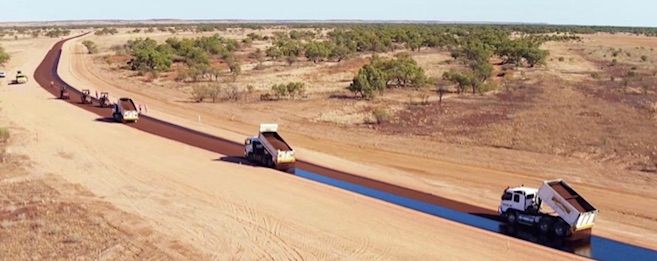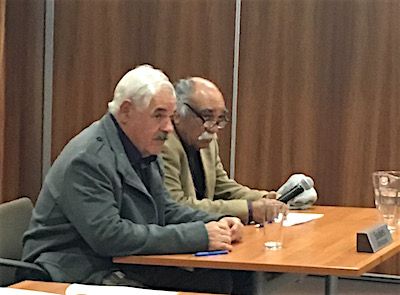Local peak coalition puts up surprising take on brighter future
24 July 2020
By KIERAN FINNANE
The acronym, CARGO, sounds cultish; the branding of priorities, “the Fantastic Five”, sounds like a kids’ adventure story, but behind them is a collaboration and a set of projects that are surprisingly people-focussed.
For once, the Central Australian future is being conceived in terms of building on the strengths of its people and their roots in this place, rather than on edifices and imported ideas imposed from above.
The development, however, has been going on behind relatively closed doors. I say ‘relatively’, because a lot of organisations are involved, and some of them are broadly representative; and ‘closed’ insofar as this has all happened, as far as I’m aware, without public discussion.
The details can be found on the NT Government’s NT Rebound site, dedicated to their pandemic economic response, which is billed as “Achieving a $40 billion economy by 2030”. Submissions “to help shape the agenda” opened on 19 June.
The CARGO submission was lodged jointly by the Alice Springs Town Council and the Chamber of Commerce on Wednesday (22 July).
The acronym stands for Central Australian Regional Group of Organisations.
Apart from the two headlining, these organisations are:-
The Regional Councils, the Central Land Council, Central Australian Aboriginal Congress, Tangentyere Council, Lhere Artepe Aboriginal Corporation, NT Police, the Alice Springs Major Business Group, Arid Lands Environment Centre, Women’s Safety Services of Central Australia, Alice Springs Youth Accommodation and Support Services, St Philip’s College, Desert Knowledge Australia, Mental Health Association of Central Australia, Gap Youth and Community Centre, Northern Territory Airports, Tourism Central Australia and Joint Defence Facility Pine Gap (it is not often that you see their logo on documents like this).
So, a diverse group.
 Of their Fantastic Five projects, first up is a “hub and spoke” model for offering Youth Facilities:
Of their Fantastic Five projects, first up is a “hub and spoke” model for offering Youth Facilities:
“The best of global youth empowerment and social investment models will guide the development of practical, supported programs delivered via a network of multi-resourced services and facilities, appropriately and collectively designed via a process of community-instigated Local Decision Making (LDM).”
Its “deliverables” are defined as a 24-hour purpose-built youth hub (possibly sited on the Melanka block), with satellite services, staffing and programs to all major sites in the region, with links back to the core services in Alice Springs.
This youth hub is a much more comprehensive proposal than the council’s current plans for a youth hub. The idea is to strengthen existing services and bring them together in an integrated network (see above, conceptual diagram from the submission).
These services would be guided by a joint board including representatives of the NT Government, Tangentyere Council, Gap Youth Centre, Child Friendly Alice, Children’s Ground, Lhere Artepe, the Town Council, schools and “other key local groups”.
The time frame is to have facilities across the region opened by July of next year. Total budget: $35m.
Number 2 is more typical of this kind of future planning – Key Infrastructure Upgrades, identified as improved internet coverage, power and flood infrastructure, and road sealing across the region (Outback Way, Tanami Road) to allow greater connectivity, uptake of solar technologies (by a majority of businesses and residents), and improved self-sufficiency.
“Communications technology is a particular priority in bridging the gap for remote communities.”
Total budget: $140m.
One specified deliverable is about playing catch-up: “Revive and complete flood mitigation work done by DIPL to date, as identified by the Alice Springs Flood Mitigation Committee” – amazing that something so critical to the town’s survival could have been allowed to drift in the way it has been.
If this group can galvanise energy and resources around its deliverables the region will be transformed.
Timeframe: design and construction of approved projects by 2023. (Road-sealing plant below, sourced from the submission.)

Number 3 is the National Aboriginal Indigenous Cultural Centre & Gallery. It shows that the lessons of the NT Government’s National Aboriginal Art Gallery process, a divisive debacle, have been learned.
CARGO is proposing a steering group jointly chaired by Mparntwarenye (belonging to Mparntwe) custodians and the National Indigenous Cultural Centre (NICC). (Pictured below are the NICC’s Owen Cole and Harold Furber, previously addressing the Town Council. Photo from our archive.)
Other “stakeholders” on the committee would include appropriate Aboriginal and non-Aboriginal representation; representatives from the Australian Government, NT Government and Alice Springs Town Council; national and international experts in the fields of tourism, cultural knowledge, gallery design and marketing; the Regional Councils and Lhere Artepe; representatives from the Central Australian community and relevant organisations, and from Desert Knowledge Precinct, Desert Park, and the Town Council “for locational considerations”.
The aim is to “provide a nationally recognised space for the exploration of Aboriginal Human Expression, through dance, art, theatre, song, music, fashion, film, literature, language, framed by the narratives of significant national songlines, alongside symposiums on anthropology, history, architecture, agriculture, social development and economic futures.”
Total budget: $350m, of which $20m is already to hand through the NT Government’s commitment to NICC.
 There are no assumptions around a single building providing this space or around location. The lion’s share of the budget – $250m – is described as being for “central and remote facilities construction across Central Australia”.
There are no assumptions around a single building providing this space or around location. The lion’s share of the budget – $250m – is described as being for “central and remote facilities construction across Central Australia”.
Number 4 is about developing a model of “Fit-for-purpose housing” for “a cross-section of people transitioning from crisis accommodation, or requiring independent but safe, secure and supported accommodation”.
The client groups are women and children escaping domestic and family violence; people with a mental health diagnosis; young people; and people leaving custody with no fixed address.
There is a bit of cross-over between this project and Number 5 which is a “Desert Living Community Model”. In Number 4 the idea is to develop six housing centres across the region, based upon a pilot village, which could be at the Desert Knowledge Precinct (aerial view at top, sourced from the submission) as part of the Desert Living Community Model.
Number 4 would be delivered by public/private partnerships, with the NT Government providing additional operational funding and various agencies, supporting the different client groups accommodated.
The Desert Living Community Model at the Desert Knowledge Precinct would become “an exemplar of arid zone research and design” for around 50 people, a model for remote Australian communities and desert regions around the world. The village would be lived in and remain as a viable community, with the model evolving through stages. The model would not only trial sustainable housing but land cultivation and things like transport options.
Total budget: $150m.
There is everything to do in front of this group – much finessing of plans before the hurdles of developing partnerships and sourcing or raising finance – and some of the timeframes seem very optimistic. But it is heartening to have such a broad coalition thinking about development in terms of improving the lives of people who live here and doing it in a way that values the desert country we live in and responds to its offerings and demands.


